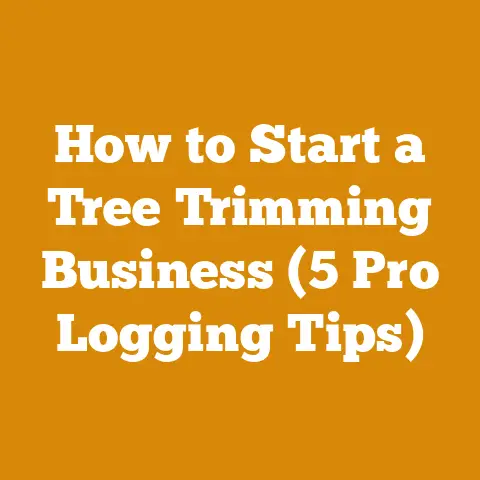Oregon EXL Chain Benefits (5 Pro Tips for Efficient Cutting)
(Image: A split image. One side shows a dull, worn chainsaw chain struggling to cut through a log, producing sawdust and burning. The other side shows an Oregon EXL chain effortlessly slicing through the same type of log, creating large, clean chips.)
Alright, let’s talk about getting the most out of your chainsaw. For years, I’ve been in the woods, felling trees, bucking logs, and splitting firewood. I’ve seen it all – from chains that dull after a single tank of gas to chains that seem to slice through anything you throw at them. And believe me, the difference is night and day. A good chain isn’t just about cutting; it’s about efficiency, safety, and saving your back. Today, I want to share my experience with the Oregon EXL chain and give you my top 5 pro tips for maximizing its cutting potential. These aren’t just generic tips; they’re born from years of trial and error, tweaked and perfected in the real world.
Oregon EXL Chain: Unleashing the Beast Within
The Oregon EXL chain, in my opinion, stands out for its balance of durability and cutting speed. It’s not the cheapest chain on the market, but it’s an investment that pays off in the long run. Let’s dive into what makes it special.
Why the EXL? The Technical Breakdown
- Chamfer Chisel Cutters: These cutters are designed for speed and efficiency. The aggressive cutting angle allows them to bite deep into the wood with minimal effort. This translates to faster cutting times and less strain on your chainsaw engine.
- LubriTec™ Oiling System: This is a game-changer. LubriTec™ keeps the chain and guide bar properly lubricated, reducing friction and wear. It’s not just about oiling the chain; it’s about delivering oil where it’s needed most. This can extend the life of your chain and bar by a significant margin. I’ve personally seen bars last twice as long when consistently using chains with a good oiling system like this one.
- Blued Cutters: Oregon’s bluing process provides superior corrosion resistance and delivers a tougher cutter. I can attest to this, I’ve used chains with and without the bluing process and I’ve noticed that the blued cutters last longer and are more durable than the non-blued cutters.
- Vibe-Ban™ Chassis: This reduces vibration at the handles by 25% or more. Trust me, after a long day of cutting, your hands will thank you. Reduced vibration also translates to better control and reduced fatigue, making the job safer.
Chain Specifications and Compatibility
It’s crucial to select the right chain for your chainsaw. Here’s a quick rundown of the key specifications to consider:
- Pitch: The distance between any three consecutive rivets divided by two. Common pitches are .325″, 3/8″, and .404″. This must match the pitch of your chainsaw’s drive sprocket and guide bar. Incorrect pitch will cause immediate damage.
- Gauge: The thickness of the drive links that fit into the guide bar groove. Common gauges are .050″, .058″, and .063″. Again, this must match the gauge of your guide bar.
- Drive Links: The number of drive links determines the length of the chain. This depends on the length of your guide bar. Consult your chainsaw’s manual or the guide bar itself for the correct number.
Example: A chainsaw with a 20-inch guide bar might require a 3/8″ pitch, .050″ gauge chain with 72 drive links.
Pro Tip: Always double-check your chainsaw’s manual or the guide bar for the correct specifications before purchasing a new chain. Mismatched chains can damage your chainsaw and pose a safety hazard.
5 Pro Tips for Efficient Cutting with the Oregon EXL Chain
Alright, let’s get to the meat of the matter. Here are my top 5 tips for getting the most out of your Oregon EXL chain.
1. Master the Art of Sharpening: Keeping the Bite Keen
A sharp chain is the single most important factor in efficient cutting. A dull chain not only cuts slower but also puts more strain on your chainsaw and increases the risk of kickback.
- Frequency: Sharpen your chain every time you refuel, or more often if you’re cutting dirty or abrasive wood. I sharpen mine at least every other tank, sometimes every tank depending on the wood.
- Tools: I recommend using a chainsaw file guide. It ensures consistent sharpening angles and depths. A round file of the correct size is essential. The file size depends on the chain pitch. For a 3/8″ pitch chain, a 5/32″ file is typically used. A depth gauge tool is also crucial for maintaining the correct depth gauge setting (more on that later).
- Technique:
- Secure the chain in a vise or clamp.
- Place the file guide on the cutter, aligning it with the cutter’s angle markings.
- File each cutter from the inside out, using smooth, even strokes.
- Maintain the correct filing angle and depth.
- File all cutters on one side, then repeat on the other side.
- Depth Gauges (Rakers): These are the small tabs located in front of each cutter. They control how much wood the cutter takes with each bite. As you sharpen the cutters, the depth gauges become relatively higher. If they are too high, the chain will not cut efficiently.
- Use a depth gauge tool to file the depth gauges down to the correct height. The recommended depth gauge setting for the Oregon EXL chain is typically .025″ (0.635mm). Consult your chain’s manual for the specific recommended setting.
- After filing the depth gauges, use a flat file to round off the front edge of each gauge. This prevents the gauges from snagging on the wood.
Personal Story: I once spent an entire day struggling to fell a large oak tree with a dull chain. I was exhausted, frustrated, and wasting a ton of fuel. Finally, I took the time to properly sharpen the chain, and the difference was unbelievable. The chainsaw sliced through the oak like butter, and I finished the job in a fraction of the time. That day, I learned the true value of a sharp chain.
Technical Insight: Studies have shown that a properly sharpened chainsaw chain can increase cutting speed by up to 50% compared to a dull chain. This translates to significant time and fuel savings.
2. Tension is Key: Finding the Sweet Spot
Proper chain tension is crucial for both performance and safety. A chain that is too loose can derail, causing damage to the chainsaw and potentially injuring the operator. A chain that is too tight can overheat, wear out prematurely, and put excessive strain on the engine.
- Checking Tension: With the chainsaw turned off and the bar held horizontally, lift the chain in the middle of the guide bar. The chain should pull away from the bar slightly, typically about 1/8″ (3mm).
- Adjusting Tension: Most chainsaws have a tensioning screw located on the side of the saw. Use a screwdriver or wrench to adjust the tension until the chain is properly taut.
- New Chains: New chains tend to stretch during the first few uses. Check the tension frequently and adjust as needed.
- Temperature: Chain tension will change with temperature. Check the tension when the chain is cold and again after it has warmed up from use.
Pro Tip: It’s better to err on the side of slightly too loose than too tight. A slightly loose chain is less likely to overheat and cause damage.
Technical Insight: Over-tensioning a chainsaw chain can increase friction by up to 30%, leading to increased wear and reduced cutting efficiency.
3. Lubrication is Life: Keeping the Oil Flowing
Proper lubrication is essential for extending the life of your chain and guide bar. The Oregon EXL chain features the LubriTec™ oiling system, which helps to distribute oil evenly across the chain and bar. However, you still need to ensure that your chainsaw’s oiler is functioning correctly and that you are using the correct type of oil.
- Oiler Adjustment: Most chainsaws have an adjustable oiler. Adjust the oiler to deliver a sufficient amount of oil to the chain. You should see a fine mist of oil being thrown off the chain while it is running.
- Oil Type: Use a high-quality bar and chain oil specifically designed for chainsaws. Avoid using motor oil or other substitutes, as they may not provide adequate lubrication and can damage the chain and bar. I personally prefer bio-degradable oils, because they’re better for the environment.
- Oil Level: Check the oil level frequently and refill as needed. Never run the chainsaw with a low oil level.
- Oiler Maintenance: Clean the oiler regularly to remove any debris that may be clogging it.
Personal Story: I once neglected to check the oil level in my chainsaw and ran it dry for a short period. The chain and bar overheated, and the bar became permanently damaged. I learned my lesson the hard way: proper lubrication is non-negotiable.
Technical Insight: A properly lubricated chainsaw chain can reduce friction by up to 50%, leading to increased cutting efficiency and extended chain and bar life.
4. Wood Selection and Cutting Techniques: Matching the Tool to the Task
The type of wood you are cutting and the cutting techniques you use can have a significant impact on the performance of your Oregon EXL chain.
- Wood Type: Hardwoods (oak, maple, hickory) are denser and more abrasive than softwoods (pine, fir, cedar). Cutting hardwoods will dull your chain faster than cutting softwoods.
- Dirty Wood: Cutting dirty wood (wood that is covered in dirt, mud, or sand) will also dull your chain faster. Clean the wood as much as possible before cutting.
- Cutting Techniques: Use proper cutting techniques to avoid pinching the chain or forcing the chainsaw. This includes using wedges when felling trees and making relief cuts when bucking logs.
- Log Diameter: The Oregon EXL chain is well-suited for cutting logs of various diameters. However, for very large logs (over 24 inches in diameter), you may need to use a longer guide bar and a more powerful chainsaw.
Data Point: Oak has a Janka hardness rating of around 1300 lbf (pounds-force), while pine has a Janka hardness rating of around 380 lbf. This means that oak is significantly harder and more resistant to indentation than pine.
Pro Tip: When cutting hardwoods, sharpen your chain more frequently and use a slower cutting speed to avoid overheating the chain.
5. Safety First: Protecting Yourself and Your Equipment
Safety should always be your top priority when operating a chainsaw. The Oregon EXL chain is a powerful tool, and it can be dangerous if used improperly.
- Personal Protective Equipment (PPE): Always wear appropriate PPE, including a helmet with a face shield, hearing protection, chainsaw chaps, gloves, and sturdy boots.
- Kickback: Kickback is a sudden, uncontrolled movement of the chainsaw that can occur when the tip of the guide bar contacts an object. Be aware of the risk of kickback and use proper cutting techniques to avoid it.
- Chain Brake: The chain brake is a safety device that stops the chain from rotating in the event of kickback. Make sure the chain brake is functioning properly before each use.
- Clearance: Clear the area around you of any obstacles before starting the chainsaw.
- Fatigue: Avoid operating the chainsaw when you are tired or fatigued.
- First Aid: Keep a first aid kit readily available in case of an injury.
Safety Code: The American National Standards Institute (ANSI) has established safety standards for chainsaw operation. Familiarize yourself with these standards and follow them carefully.
Technical Insight: Chainsaw-related injuries account for a significant number of logging and wood processing accidents each year. Wearing proper PPE and following safe operating procedures can significantly reduce the risk of injury.
Bonus Tip: Storing Your Chain
When you are not using your chainsaw, it’s important to store the chain properly to prevent rust and corrosion. Clean the chain thoroughly and apply a light coat of oil before storing it in a dry place. I sometimes wrap them in an oily rag.






